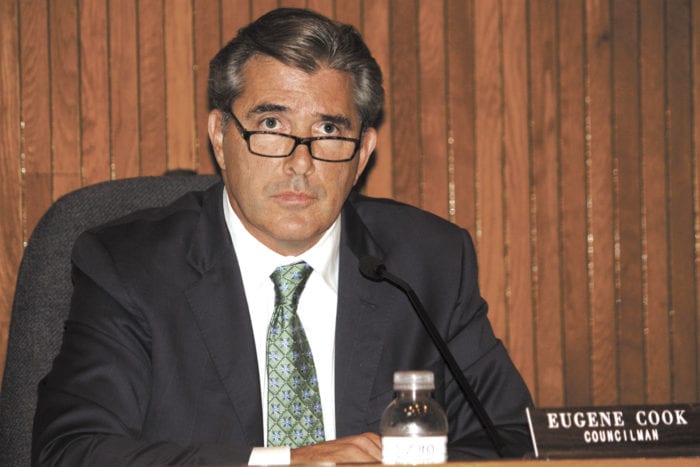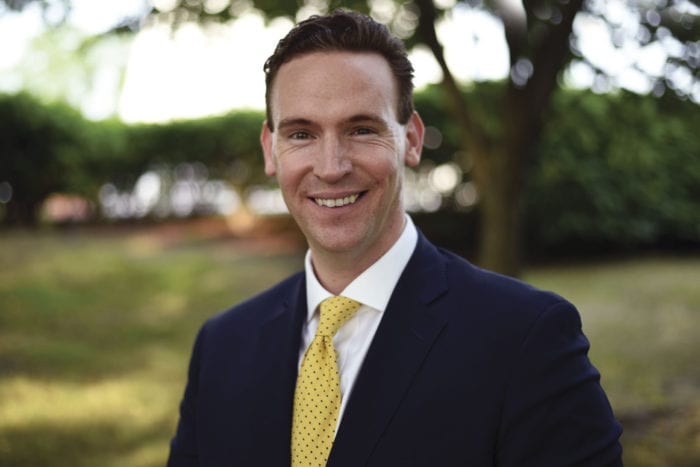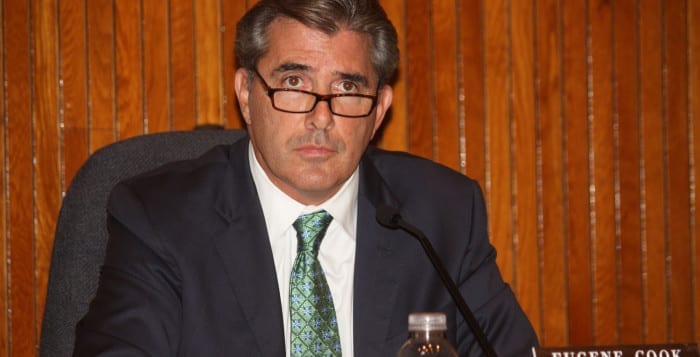By Rita J. Egan
When Vice News premiered a documentary on HBO about the recent rally in Charlottesville, Virginia, the story took a local twist when it featured former Stony Brook resident Christopher Cantwell.
Cantwell, who currently lives in Keene, New Hampshire, is a white supremacist who hosts an alternative right call-in show, “Radical Agenda,” which is live streamed through Facebook and UStream. In the Vice documentary, he can be seen with other marchers holding torches and chanting: “Jews will not replace us” and “White lives matter.” During the filming, after being sprayed with mace in his eyes, he said he was attacked by counter-protesters and called them “communists.”
Cantwell did not respond to multiple different requests for comment. Calls to a residence connected to him on Skylark Lane in Stony Brook were not answered, and when a News 12 Long Island reporter approached a man in the driveway of the home, the man denied knowing Cantwell. It was seen on his website in recent days that Cantwell now fears for his life.
Vice documentary
After seeing the Vice documentary, one of Cantwell’s childhood friends, who declined to be interviewed, reacted on Facebook.
“I remember five years ago when I removed him from my page when he started spewing hate speech,” he said. “I may not agree with our government, but I’ll be dead before I align myself with people like this. All of this makes it too real, too close to home and too sad to even comprehend. I feel bad for them really, to live life based solely on hatred of people for a reason based solely in their minds.”
The last mention of a Cantwell in the Ward Melville High School yearbooks was in 1997. He was listed as a camera-shy sophomore.
His website provides insight into his white supremacist beliefs and why he participated in protesting the removal of a statue of Gen. Robert E. Lee in Charlottesville’s Emancipation Park.

“Here at the Radical Agenda, we’ve made no secret of our utter contempt for the subhuman filth commonly referred to as the Left,” he wrote Aug. 7. “Their Marxist, anti-human war on reality is an ideological contaminant that makes HIV look appealing by comparison. So, we’ve literally made a career out of producing war propaganda against them.”
On Aug. 10, before the rally that resulted in the death of 32-year-old Heather Heyer, he posted a message on his website that could only be seen in its entirety if the reader was an existing paying member to his site. He had disabled new membership sign-ups.
“I’m in Charlottesville, Virginia for the Unite the Right Rally this coming Saturday,” he said in a preview of the post. “Since we have been meeting so much opposition from both the criminal elements and the municipal government alike, we’ve had to exercise a great deal of caution in terms of operational security.”
Cantwell said he was with a reporter, Elle Reeve from Vice, who was covering the rally.
After the documentary aired on HBO, a photo surfaced of Cantwell attacking someone with pepper spray. In an Aug. 17 post on his website he referenced the photo. He said the man was coming directly for him and another person was approaching him from his left, and believed his safety was being threatened.
“I sprayed in self-defense, while holding a flashlight in my left hand,” he said. “In my mind, this was the minimal level of force I could use to deter this threat.”
He posted a YouTube video saying he feared he would be arrested, and appeared on the verge of tears. In the Aug. 17 website post, he said he was preparing to turn himself over to University of Virginia police. Calls to the police department to confirm warrants were issued were not returned. Although the Vice film showed him unloading guns strapped to his waist and legs onto the bed of a hotel room, he said he did not bring his guns to the rally.
Cantwell living locally
Cantwell is no stranger to run-ins with the law, according to Southern Poverty Law Center’s website, a watch group dedicated to fighting hate and bigotry. In 2000, Cantwell pleaded guilty to fifth-degree criminal possession of stolen property, fourth-degree criminal possession of a weapon and driving while intoxicated in Suffolk County. He served four months of a six-month jail sentence. During a failed attempt to run to represent New York’s 1st Congressional District in 2009 as a Libertarian candidate, he was arrested a second time for DWI. He faced up to two years in prison. He eventually took a deal and served 28 days of a 45-day plea bargain.
Cantwell admitted to his DWI arrests in a speech he gave at a Suffolk/Nassau Libertarian Party Convention June 14, 2014. He said at the age of 19 he became very drunk and while driving his car realized he was too drunk to drive and parked his car to sleep. He said the next day he woke up in jail. Nine years later, he said he was out on a date and said he was careful with the amount of drinking he was doing. He was pulled over for speeding in East Hampton. His blood alcohol limit was measured at .01 over the legal limit. In the speech, Cantwell said before the trial his vehicle was seized and his driver’s license suspended. Due to paying thousands in bail and attorney fees, he lost his job and apartment.
“New York is a hopeless cesspool of government violence and corruption.”
— Christopher Cantwell
He began to study government, and said he started to “figure out that government is a violent, evil monster portraying itself as a peacemaker and savior.”
“That far from being that which brings order to society, it is responsible for more carnage and misery than any other institution in the history of mankind,” he said.
During the convention speech, Cantwell said he was leaving New York.
“New York is a hopeless cesspool of government violence and corruption,” he said.
In another Aug. 17 post, Cantwell said he was blocked by PayPal, Venmo, Facebook,
Instagram, Twitter, and MailChimp. He discovered his online dating profiles at OKCupid, Match and Tinder were disabled — sites he said he used for the pursuit of romance.
East Setauket’s Stefanie Werner, although hoping that others don’t associate white
supremacy with the Three Villages, can see how a mindset like Cantwell’s develops.
“The news about a white supremacist with roots in the Three Village area, although disturbing, should not be altogether shocking,” she said. “I have lived here all of my life and began my teaching career at Ward Melville. Walking the halls of Ward Melville High School, or any other high school in the country, there exists a diverse set of personalities that have yet to fully develop. Adolescent ideals turn to adult ideologies, and it only takes one experience, positive or negative, to help mold these beliefs into a solid foundation. It is sad, and a tad frightening that this particular mindset developed in a community where many may turn a blind eye to the existence of this antithetical culture. However, the current political arena is nurturing this thought process, and this community needs to heighten its awareness of the clashing principles of the modern era.”

Community reaction
Three Village residents and religious leaders were asked how they felt when they heard Christopher Cantwell was from Stony Brook.
Terry Shapiro: “As an American Jew, I am horrified. Anti-Semitism has a long history in Suffolk County. That is why it is so important to have a representative who speaks out firmly against bigotry in the White House. U.S. Rep Lee Zeldin (R-Shirley) has not done so. He has not held Mr. Trump accountable. As long as we have a bigot in the White House and members of Congress who refuse to censure him, I fear that anti-Semitism will continue to resurface.”
Rabbi Steven A. Moss (chairperson of the Suffolk County Human Rights Commission): “There’s no place on earth that is exempt from this kind of behavior. The question then becomes what do the rest of us do. Therefore what we try to do is model ourselves on the idea that evil occurs when good people do nothing. So we organize task forces and people. We need to speak out and make sure we condemn when appropriate this kind of behavior and speak out against it and not simply turn aside.”
Shoshana Hershkowitz: “Chris Cantwell is a reminder that hate exists in all communities. It is deeply upsetting to me that a young man who was raised in our area, was taught in our schools, came away with this frightening worldview and ideology. We need to examine the racism that exists where we live and confront it in our homes and schools. This must be our response to hate if we are to combat it effectively.”
Arnold Wishnia: “I learned that Cantwell came from Stony Brook from you. I Googled him and discovered that I had in fact seen the TV clip where this vile Nazi boasted about strengthening himself for violence, and said he would kill if he had to. Cantwell may be an extreme, but I am not shocked that violence-prone racists can be found in Stony Brook. Suffolk County has a history of KKK and Nazi activity from the 1930s. My sons encountered this kind of unthinking, violence-threatening racism as students at Ward Melville High School, I am disturbed and disappointed to find out that anyone is a Nazi, but not surprised that Stony Brook has bred some.”
The Rev. Kate Jones Calone (director of Open Door Exchange at Setauket Presbyterian Church): “We cannot pretend that prejudice and racism do not exist in our area, whether explicit, subtle or unintentional. The question is how we address it. In my faith, God grieves over separation and longs for reconciliation. If we are to build a community grounded in equity and love, we need first to understand why things are not that way and take action to change it. This requires real commitment, hard work, humility and a willingness to confront what stands in the way. Starting in elementary school, schools, parents and adult leaders need to teach more than simple kindness; they need to teach kids to be affirmatively and actively inclusive and anti-racist. And we need to educate ourselves on why Long Island is among the top 10 most segregated places in the country.”

















